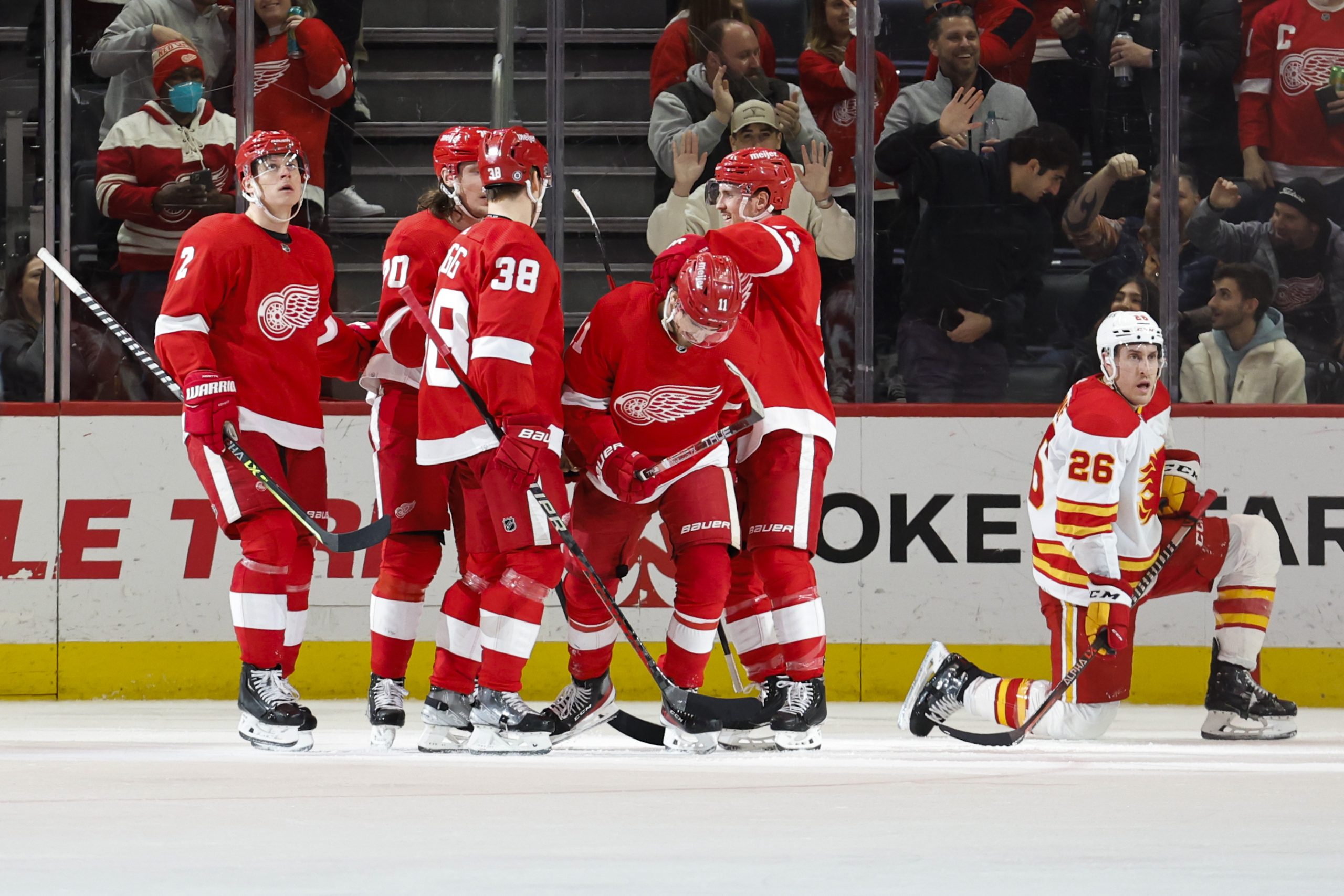Main Photo: Rick Osentoski-USA TODAY Sports
We are more than halfway through this NHL season, and the Detroit Red Wings find themselves far removed from a playoff position. It may be easy to pile on the challenges the Red Wings have faced this season, yet today we are going to look at which Detroit Red Wing line combinations are the highest performing so far in 2022-23.
This Seasons Best Line Combos for the Detroit Red Wings
Ground Rules
Here is a statistical approach when analyzing line combinations, as the eye test often misses subtle things like play-driving ability. For this analysis, I have tapped Natural Stat Trick, a website providing many different types of data for the NHL. We have excluded lines that have only played together in one game, as well as lines that have spent fewer than 25 minutes together. The big downside to this is that certain players who have not played much and have changed lines a lot do not get a favorable look. Robby Fabbri, Tyler Bertuzzi, and Filip Zadina all suffer for this reason.
The Best of the Best
The best line combination statistically for the Red Wings has been Dominik Kubalik, Joe Veleno, and Elmer Soderblom. This was a fourth line for a four-game stretch, and they dominated the 28 minutes they spent together. That is a small sample size, but they drove play well in that time. They have the best Corsi For Percentage (CF%) among Red Wings lines, at 58.33%. Their Expected Goals For Percentage (xGF%) and their Scoring Chance For Percentage (SCF%) are second at 62.06% and 59.26% respectively.
You have to factor in two main things when talking about this line. First, the sample size. They barely played together, but when they did, it was exceptional. Second, they were a bottom-six line, playing against bottom-six competition. They did not have superstars to go up against every shift, yet they were effective in their role.
The Best Top Line
The best top line may not be who you expect, but something will click. The second-best line overall, and the best line playing against top opposition has been David Perron, Michael Rasmussen, and Dylan Larkin on the wing. They finished in the top five in every category, and were the best in three of those categories.
The challenge with this analysis comes when looking at xGF% and actual Goals For Percentage (GF%). When playing together, they should outscore their opponents about three to two, a 65.58% xGF%. In actual play, they have been outscored four to five, a GF% of 44.44%.
This is most likely explained by two factors. First, they play the best their opponents have to offer, as Lalonde never takes Larkin off the top line. Second, Larkin was recovering from some sort of hand injury, hence why Rasmussen was centering this line. Larkin struggled to score and often deferred good scoring chances to his linemates. Even with that, this has been the best of all the Detroit Red Wings line combos this season.
The Veteran Line
Another line that did extremely well to start the season was David Perron, Dylan Larkin, and Dominik Kubalik. This line played together for 11 games and outscored their opponents eight to four in that span. They played against other top lines and drove play well with a CF% of 56.55%.
It may be a stretch to call Kubalik a veteran, but he has been around for a few seasons, and he exceeded as the trigger man alongside Larkin and Perron, two players who are also huge threats to score. Unfortunately, a combination of injuries to Bertuzzi and the loss of Vrana led to this line being split up.
The Worst Line
When dubbing “the offseason addition line” has proved terrible in the time they have spent together. David Perron, Andrew Copp, and Dominik Kubalik have played seven games together in a second-line role, and it has not gone well. They have not driven play, they have been outscored two to four, and they have been caved in the defensive zone.
One stat we have not talked about yet is Rebound Attempts For % (RAF%). This measures the rebounds this line has had versus the rebounds they have had against them. Their RAF% is 0%. In their time together, they did not generate one shot off a rebound, while their opponents had eight. The Red Wings average about three and a half rebounds for and four against per line. This, alongside a dismal 40.16% CF%, shows that this line just did not mesh together.
The Detroit Red Wings Forward Lineup
Before choosing lines we have to remember that now Soderblom and Erne are in the AHL, while Fabbri, Bertuzzi, and Zadina are back on the roster. This means that if we want to include two of the latter players, we cannot only use lines that met our statistical parameters. With this in mind, and the stats above, here are my Detroit Red Wing line combos for the rest of the season:
On the top line, we put David Perron, Dylan Larkin, and Dominik Kubalik together. They dominate together, and this maximizes Kubalik’s potential.
On the second line, we have Lucas Raymond, Andrew Copp, and Tyler Bertuzzi. This line does not meet our games played parameters, but has shown well in one game together, and allows Copp to play off two highly skilled offensive wingers.
For the third line, we will ice Robby Fabbri, Joe Veleno, and Jonatan Berggren. This offensive trio has played well together over a three-game span, with a 50.35% xGF%. They would need to get some goals on the board though, as they have not scored when playing together yet to date. With Berggren distributing to Fabbri and Veleno transporting the puck up and down the ice, it would not be long before they found the scoresheet.
The fourth line is Pius Suter, Michael Rasmussen, and Oskar Sundqvist. Rasmussen was almost a first-liner in this exercise, and Suter has been playing extremely well of late. Most recently, he poke-checked and laid out Connor McDavid. Sundqvist has had an up-and-down year but has done well in a bottom-of-the-lineup role. This line has not played together much, but lines of Erne-Rasmussen-Sundqvist, as well as Erne-Suter-Sundqvist, have done okay this year, with a CF% of about 45.5%.






